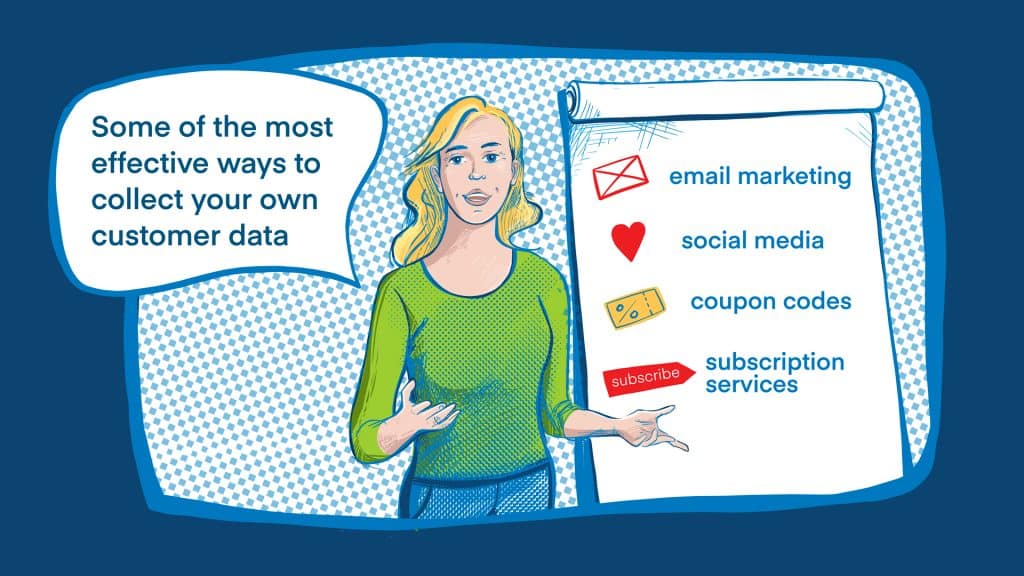
Ecommerce has always been a data-driven industry. With the right information (and tools), you can attract new customers, retain existing ones, and optimize your sales funnel to grow as an omnichannel retail success story. At the same time, the breadth of market and consumer data is constantly evolving, as is its availability.
Privacy concerns, legal changes, and marketplace terms of service create an ever-shifting definition of what information your marketing team can access about your customers. Things are about to get more complicated once again, but with the right marketing moves today, you can get in front of one of the most drastic evolutions in consumer privacy in years.
The Death of the Third-Party Tracking Cookie is an E-Marketing Inflection Point
Cookies are small data files created on users’ devices when they visit certain (almost all) websites. They come in two flavors that both behave in similar ways. The key difference is in their reach:
First-party cookies are tied to the specific webpage or domain that creates them. They store information relevant to the user’s experience and behavior while visiting the site. This information can include location, user logins, and on-site activity history.
Third-party cookies are created by a specific domain but track user information and behavior on sites beyond that original domain. These cookies can create a much wider and more complete picture of a user, which is why they are such a useful marketing tool and why online megaliths like Google and Facebook have long relied on them as marketing gold mines.
With the passage of anti-tracking legislation in Europe and California, the effectiveness and viability of cookie-based third-party tracking tools are nearing their end. Customers outside those locales are increasingly becoming cookie-free as well. In the past year, popular internet browsers like Firefox and Safari have allowed users to block tracking cookies outright. Google Chrome is set to follow suit by 2023.
For ecommerce sellers, this foreshadows changes coming in how you need to approach your marketing efforts. As they stand, top-of-funnel marketing services like Google Ads and Facebook Ads can surface hyper-relevant marketing to consumers through extensive cookie-based analytics.
While it is safe to assume that both companies will find new ways to generate profitable server-side, third-party advertising alternatives (like digital fingerprinting and Google’s FLoC initiative), this inflection point may be an ideal time to assess how your omnichannel ecommerce brand can take control by generating and welding your own first-party customer data.

Use Your Own First-Party Data to Personalize Customers’ Online Retail Experiences
Part of the challenge of online sales is connecting with customers without making them feel like just another digital data point. The line between a tailored shopping experience and a creepy invasion of privacy is delicate and dangerous.
In most cases, when shopping on third-party marketplaces, customers know that they are being tracked and steered by their order histories, searches, and on-site (or in-app) behaviors. Sometimes, even off-site searches may generate data to surface new merchandise recommendations.
Many users simply accept this as part of the cost of doing business—a minor invasion of privacy in exchange for a large selection, low prices, and fast shipping. It’s a mega-corporation doing what mega-corporations do.
First-party ecommerce web pages don’t often get that same free pass. Users are looking for convenience, but they also need to establish trust before offering up their personal information to a new website.
That said, data is king. You can’t offer customers a boutique experience that competes with or exceeds the industry leaders’ without some idea of your shoppers’ intentions. The key may be as simple as basic etiquette: don’t take, ask.
Rather than solely relying on gathering information in the background, users should be given the option to opt in to share relevant data to help improve their own shopping experience.
Some of the most effective ways to get customers to volunteer useful information you can leverage to help move them through the sales funnel include:
Email Marketing
Offer customers an opportunity to receive updates about your products as well as relevant, curated content. Enticing signups with one-off discounts or the promise of exclusive sales and product information can sometimes be enough to convince customers to offer some relevant identifying info in exchange.
Keep the channel open (and promote sharing) by ensuring your content is consistently fresh and relevant. For email marketing to work, it must be seen as a value-added service, not just another piece of spam-filtered junk mail.
Social Media
You can learn a lot from your customers based solely on what they share with the world on social media. Creating and maintaining a viable and appealing social media presence can be a great way to promote brand awareness while connecting with your current and potential customer bases. The data that you can acquire from following and engagements can be extremely useful in cultivating effective first-party sales leads and strategies.
Coupon Codes
Whether through social media or targeted email campaigns, getting the right offers to the right customers can work wonders for boosting your sales conversion rate and reducing abandoned carts.
Subscription Services
Taking a page from the industry leaders’ playbooks, consider creating a subscription-based loyalty program to promote customer loyalty and build relationships. This can be a free opt-in or include paid benefit tiers that offer additional enticements like discounts and/or shipping-cost reductions.
This type of first-party marketing has been a particularly valuable strategy as more customers have demonstrated an increased willingness to expand their shopping destinations online. What’s more, it is working. A Digital Commerce 360 report showed that “35.9% of retailers ranked in the 2021 Digital Commerce 360 Top 500 offered a free loyalty program in 2020, up from 26.0% the year before.”
Descartes Sellercloud’s robust collection of features, integrations, and tools can provide a reliable back-end to support these activities, allowing you to capitalize on personalized omnichannel ecommerce experiences and maximize your first-party sales growth potential.
Of course, gathering data is useless unless it can be organized and put to good use. With Zapier’s automations, everything from creating customized email marketing content to automated coupon code creation to proactive order-tracking communication can be streamlined. Taken further, Descartes Sellercloud’s compatibility with PowerBI allows you to leverage that same first-party data for deep analytics and data-based decision-making on both the micro and macro levels.
Contact us for a free demo to learn how Descartes Sellercloud can help keep your ecommerce brand running smoothly.




